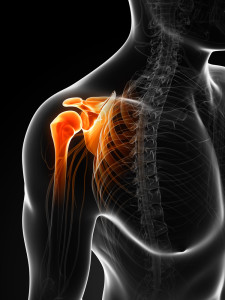 Frozen shoulder is a seriously debilitating condition that can significantly affect your daily functioning and cause a lot of pain and discomfort. It is characterized by a loss of shoulder mobility in nearly all directions of movement- as if the shoulder has literally frozen in place; and any attempts to move it can be incredibly painful.
Frozen shoulder is a seriously debilitating condition that can significantly affect your daily functioning and cause a lot of pain and discomfort. It is characterized by a loss of shoulder mobility in nearly all directions of movement- as if the shoulder has literally frozen in place; and any attempts to move it can be incredibly painful.
Not only can you not move your arm, but also your doctor cannot move your arm without inflicting pain. In technical terms, there are restrictions in both active range of motion (you creating the movement yourself) and passive range of motion (the doctor creating the movement for you) 1. External rotation movements, such as washing your hair, are usually the worst 1.
Also known as adhesive capsulitis, frozen shoulder occurs when the shoulder capsule (the connective tissue surrounding the joint) becomes inflamed, thickened and potentially even scarred1. Pain can be excruciating, and usually gets worse at night, particularly when lying on the affected side, and with cold weather 2.
Do you suffer from shoulder pain? Do you struggle to move your arm as far as you used to? Fortunately, frozen shoulder is treatable. Call Spine Scan now on (08) 61508785 Scarborough or (08) 61508783 Mount Pleasant to arrange an appointment and find out how we can help.
Causes of Frozen Shoulder
No one really knows why some people get frozen shoulder. It is believed to be closely related to trauma, immobility, and may also have an autoimmune component 2. There are also some patients who are at more of a risk of developing the condition. Specifically, it is more common in women than men, particularly between the ages of 40-70 years old 3.
Those suffering from diabetes, rheumatoid arthritis, shoulder osteoarthritis and those who have had a history of trauma to the region are also much more likely to present with frozen shoulder 1. Not only are they more likely to present with frozen shoulder, but they also usually present with more severe forms of frozen shoulder as well 1.
Interestingly, frozen shoulder has also been associated as a complication of chest surgery 4. Thoracotomy (the technical name for chest surgery) is usually performed due to breast and lung pathology, such as cancers. The adverse effects of surgery are well-known 4. With thoracotomy, these can include respiratory difficulties, pneumonia, chronic pain and shoulder problems. 4
When pain is chronic, it can lead to changes in nerve tissues so that pain may persist even after the stimulus is removed or the damage is repaired. As part of the surgery, incisions are made through the muscles. This can lead to scar tissue formation, which may impact on that muscle’s ability to function normally. These muscle imbalances as well as immobilization due to pain may then result in frozen shoulder 4. If you have recently had surgery, it is worth discussing with your health care practitioner viable rehabilitation strategies in order to maintain mobility in that region. We will happily advise you on this.
Maintaining movement is considered the best prevention strategy for frozen shoulder. It may seem counter-intuitive to want to move it when it is painful, however this movement will prevent the development of adhesions that lead to the loss of motion within the joint.
The Stages of Frozen Shoulder
Frozen shoulder is often broken up into 3 stages:
- Stage 1, or the “freezing” stage. This is the stage associated with the slow onset of pain in which the shoulder begins to lose its range of motion. This stage usually lasts 6 weeks- 9 months
- Stage 2, or the “frozen” phase. This is the stage where the patient presents with classic frozen shoulder- ie. they struggle to move their arm at all. It can last up to 9 months in this stage. This may impact on both the patient’s physical and mental health. Many patients suffer from depression during this stage due to an inability to function as they used to. For physical professions, such as manual labourers, frozen shoulder can greatly impact on their ability to work, leading to economic stress on top of everything else.
- Stage 3, or the “thawing” phase. This is the recovery phase. It will usually last 5-26 months 1.
Frozen shoulder is treated very aggressively, due to the severity of the pain and the long-term health effects of immobility both physically and psychologically 1. Without treatment, frozen shoulder may be permanent 3.
Treatment
The typical treatments prescribed by practitioners consist of a combination of anti-inflammatory medication, cortisone injections and manual therapy 2. In some patients, the combination of these treatments may not be enough, and they may require surgery to break down the scar tissue. Known as ‘manipulation’, the physician puts the patient under anesthetic and surgically breaks up the adhesions within the joint. It must be done extremely carefully as it may lead to a fracture of the humerus 1. Also, one cannot forget that surgery was a risk factor for frozen shoulder in the first place!
At Spine Scan, Perth chiropractor Dr Adam Rocchi, has done additional training in the treatment of frozen shoulder using a treatment approach known as Trigenics. Trigenics focuses in detail on any imbalances in muscle function, and corrects them to allow normal function of the shoulder to return more quickly. This is done without the need for general anesthetic or dangerous forced manipulation.
Generally, the prognosis is fairly good 1. Most patients do not require surgery and are able to regain roughly 90% of their shoulder range of motion 4. Physical therapy like our therapies and rehabilitation are vital components of this recovery. In addition to the Trigenics approach, some modalities often used include: ultrasound, electric stimulation, stretching, icing, mobility exercises, and eventually muscle strengthening and reconditioning. Full recovery can take weeks to months, depending on the degree of scar tissue in the area 1.
Patients also have to be very careful of not injuring the shoulder further during recovery. They should avoid heavy lifting and sudden, jerky movements that may exacerbate the injury! Other treatments for frozen shoulder may include acupuncture or transcutaneous electrical nerve stimulation (TENS). This delivers a tiny electrical current to key points along a nerve pathway. Although it is not exactly certain how TENS works, it is theorized that this electrical stimulation causes the release of endorphins and blocks pain fibers carrying pain 1.
Getting Help
Frozen shoulder can be a very uncomfortable condition. However, with proper treatment, normal shoulder movement can be restored. If you are suffering from shoulder pain, am struggling to move your arm, or just want to know more about how to strengthen your shoulder muscles, call the practice now on (08) 61508785 Scarborough or (08) 61508783 Mount Pleasant to arrange an appointment.
References:
- Shiel W. Frozen shoulder 2016 [27/04/2016]. Available from: http://www.medicinenet.com/frozen_shoulder/article.htm.
- Staff MC. Frozen shoulder 2015 [27/04/2016]. Available from: http://www.mayoclinic.org/diseases-conditions/frozen-shoulder/basics/definition/con-20022510.
- Ewald A. Adhesive capsulitis: a review. American Family Physician. 2011;83(4):417-22.
- Gerner P. Post-thoracotomy pain management problems Anesthesiol Clin. 2008;26(2):355-vii.


No comments yet.